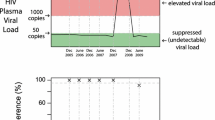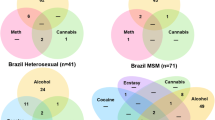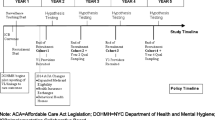Abstract
We examined the relationship between residential eviction and exhibiting detectable plasma HIV-1 RNA viral load (VL) among a prospective cohort of antiretroviral therapy (ART)-exposed HIV-seropositive people who use illicit drugs (PWUD) in Vancouver, Canada. We used multivariable generalized estimating equations to estimate the effect of residential eviction on detectable VL and examine ART adherence as a mediating variable. Between June 2007 and May 2014, 705 ART-exposed participants were included in the study, among whom 500 (70.9 %) experienced at least one period of detectable VL. In a time-updated multivariable model, eviction independently increased the odds of detectable VL among those who were homeless [adjusted odds ratio (AOR) = 2.25; 95 % confidence interval (CI) 1.18–4.29] as well as not homeless (AOR = 1.76; 95 % CI 1.17–2.63) post eviction. The results of mediation analyses suggest that this association was mediated by incomplete ART adherence. These findings suggest the need for further development and evaluation of interventions to prevent evictions and promote ART adherence among PWUD facing eviction.
Similar content being viewed by others
References
Wood E, Hogg RS, Lima V, et al. Highly active antiretroviral therapy and survival in HIV-infected injection drug users. JAMA. 2008;300(5):550–4.
Wood E, Hogg RS, Yip B, Harrigan PR, Montaner JSG. Why are baseline HIV RNA levels 100,000 copies/mL or greater associated with mortality after the initiation of antiretroviral therapy? J Acquir Immune Defic Syndr. 2005;38(3):289–95.
Cohen MS, Chen YQ, McCauley M, et al. Prevention of HIV-1 infection with early antiretroviral therapy. New Engl J Med. 2011;365(6):493–505.
World Health Organization. Programmatic update: antiretroviral treatment as prevention (TASP) of HIV and TB: executive summary. 2012. http://apps.who.int//iris/handle/10665/70904.
Robbins GK, Johnson KL, Chang Y, et al. Predicting virologic failure in an HIV clinic. Clin Infect Dis. 2010;50(5):779–86.
Lucas GM, Chaisson RE, Moore RD. Highly active antiretroviral therapy in a large urban clinic: risk factors for virologic failure and adverse drug reactions. Ann Intern Med. 1999;131(2):81–7.
Lucas GM, Cheever LW, Chaisson RE, Moore RD. Detrimental effects of continued illicit drug use on the treatment of HIV-1 infection. J Acquir Immune Defic Syndr. 2001;27(3):251–9.
Palepu A, Tyndall M, Yip B, O’Shaughnessy MV, Hogg RS, Montaner JSG. Impaired virologic response to highly active antiretroviral therapy associated with ongoing injection drug use. J Acquir Immune Defic Syndr. 2003;32(5):522–6.
Chander G, Himelhoch S, Fleishman JA, et al. HAART receipt and viral suppression among HIV-infected patients with co-occurring mental illness and illicit drug use. AIDS Care. 2009;21(5):655–63.
Weber R, Huber M, Rickenbach M, et al. Uptake of and virological response to antiretroviral therapy among HIV-infected former and current injecting drug users and persons in an opiate substitution treatment programme: the Swiss HIV Cohort Study. HIV Med. 2009;10(7):407–16.
Altice FL, Kamarulzaman A, Soriano VV, Schechter M, Friedland GH. Treatment of medical, psychiatric, and substance-use comorbidities in people infected with HIV who use drugs. Lancet. 2010;376(9738):367–87.
Strathdee SA, Hallett TB, Bobrova N, et al. HIV and risk environment for injecting drug users: the past, present, and future. Lancet. 2010;376(9737):268–84.
Milloy M-J, Marshall BDL, Kerr T, et al. Social and structural factors associated with HIV disease progression among illicit drug users: a systematic review. AIDS. 2012;26(9):1049–63.
Rhodes T, Singer M, Bourgois P, Friedman SR, Strathdee SA. The social structural production of HIV risk among injecting drug users. Soc Sci Med. 2005;61(5):1026–44.
Rhodes T. The, “risk environment”: a framework for understanding and reducing drug-related harm. Int J Drug Policy. 2002;13(2):85–94.
Milloy MJ, Kerr T, Buxton J, et al. Dose-response effect of incarceration events on nonadherence to HIV antiretroviral therapy among injection drug users. J Infect Dis. 2011;203(9):1215–21.
Piketty C, Castiel P, Giral P, et al. Lack of legal income is strongly associated with an increased risk of AIDS and death in HIV-infected injecting drug users. AIDS Care. 1999;11(4):429–36.
Knowlton A, Arnsten J, Eldred L, et al. Individual, interpersonal, and structural correlates of effective HAART use among urban active injection drug users. J Acquir Immune Defic Syndr. 2006;41(4):486–92.
Milloy M-J, Marshall BDL, Montaner J, Wood E. Housing status and the health of people living with HIV/AIDS. Curr HIV/AIDS Rep. 2012;9(4):364–74.
Palepu A, Milloy M-J, Kerr T, Zhang R, Wood E. Homelessness and adherence to antiretroviral therapy among a cohort of HIV-infected injection drug users. J Urban Health. 2011;88(3):545–55.
Knowlton AR, Arnsten JH, Eldred LJ, et al. Antiretroviral use among active injection-drug users: the role of patient-provider engagement and structural factors. AIDS Patient Care STDS. 2010;24(7):421–8.
Milloy M-J, Kerr T, Bangsberg DR, et al. Homelessness as a structural barrier to effective antiretroviral therapy among HIV-seropositive illicit drug users in a Canadian setting. AIDS Patient Care STDS. 2012;26(1):60–7.
Kidder DP, Wolitski RJ, Campsmith ML, Nakamura GV. Health status, health care use, medication use, and medication adherence among homeless and housed people living with HIV/AIDS. Am J Public Health. 2007;97(12):2238–45.
Lieb S, Brooks RG, Hopkins RS, et al. Predicting death from HIV/AIDS: a case-control study from Florida public HIV/AIDS clinics. J Acquir Immune Defic Syndr. 2002;30(3):351–8.
Chum A. The impact of gentrification on residential evictions. Urban Geogr. 2015;2015:1–16.
Carey CA. No second chance: people with criminal records denied access to public housing. U Tol L Rev. 2004;2005(36):545.
Dickson-Gomez JB, Convey M, Hilario H, Corbett AM, Weeks M. Structural and personal factors related to access to housing and housing stability among urban drug users in Hartford, Connecticut. Contemp Drug Probl. 2008;35(1):115–52.
Dickson-Gomez JB, Cromley E, Convey M, Hilario H. How much choice is there in housing choice vouchers? Neighborhood risk and free market rental housing accessibility for active drug users in Hartford, Connecticut. Subst Abuse Treat Prev Policy. 2009;4(1):5.
Phinney R, Danziger S, Pollack HA, Seefeldt K. Housing instability among current and former welfare recipients. Am J Public Health. 2007;97(5):832–7.
Cooper HLF, Wodarski S, Cummings J, et al. Public housing relocations in Atlanta, Georgia, and declines in spatial access to safety net primary care. Health Place. 2012;18(6):1255–60.
Pollack CE, Lynch J. Health status of people undergoing foreclosure in the philadelphia region. Am J Public Health. 2009;99(10):1833–9.
Strathdee SA, Palepu A, Cornelisse PG, et al. Barriers to use of free antiretroviral therapy in injection drug users. JAMA. 1998;280(6):547–9.
Palepu A, Tyndall MW, Joy R, et al. Antiretroviral adherence and HIV treatment outcomes among HIV/HCV co-infected injection drug users: the role of methadone maintenance therapy. Drug Alcohol Depend. 2006;84(2):188–94.
Uhlmann S, Milloy M-J, Kerr T, et al. Methadone maintenance therapy promotes initiation of antiretroviral therapy among injection drug users. Addiction. 2010;105(5):907–13.
Sangsari S, Milloy M-J, Ibrahim A, et al. Physician experience and rates of plasma HIV-1 RNA suppression among illicit drug users: an observational study. BMC Infect Dis. 2012;12(1):22.
Wood E, Montaner JSG, Yip B, et al. Adherence and plasma HIV RNA responses to highly active antiretroviral therapy among HIV-1 infected injection drug users. CMAJ. 2003;169(7):656–61.
Maldonado G, Greenland S. Simulation study of confounder-selection strategies. Am J Epidemiol. 1993;138(11):923–36.
Ti L, Milloy M-J, Shannon K, et al. Suboptimal plasma HIV-1 RNA suppression and adherence among sex workers who use illicit drugs in a Canadian setting: an observational cohort study. Sex Transm Infect. 2014;90(5):418–22.
Bangsberg D, Tulsky JP, Hecht FM, Moss AR. Protease inhibitors in the homeless. JAMA. 1997;278(1):63–5.
Scott A, Ellen J, Clum G, Leonard L. HIV and housing assistance in four U.S. cities: variations in local experience. AIDS Behav. 2007;11(6 Suppl):140–8.
Azar P, Wood E, Nguyen P, et al. Drug use patterns associated with risk of non-adherence to antiretroviral therapy among HIV-positive illicit drug users in a Canadian setting: a longitudinal analysis. BMC Infect Dis. 2015;15:193.
Thiele B. The human right to adequate housing: a tool for promoting and protecting individual and community health. Am J Public Health. 2002;92(5):712–5.
Desmond M. Eviction and the reproduction of urban poverty. Am J Sociol. 2012;118(1):88–133.
Wolitski RJ, Kidder DP, Pals SL, et al. Randomized trial of the effects of housing assistance on the health and risk behaviors of homeless and unstably housed people living with HIV. AIDS Behav. 2010;14(3):493–503.
Acknowledgments
The authors thank the study participants for their contribution to the research, as well as current and past researchers and staff. We would specifically like to thank Cody Callon, Deborah Graham, Peter Vann, Steve Kain, Kristie Starr, Tricia Collingham, and Carmen Rock for their research and administrative assistance. The study was supported by the United States National Institutes of Health (R01DA021525 and R01DA033147). This research was undertaken, in part, thanks to funding from the Canada Research Chairs program through a Tier 1 Canada Research Chair in Inner City Medicine, which supports Dr. Evan Wood. Mary Clare Kennedy is supported by Mitacs through the Mitacs Accelerate Program. M-J Milloy is supported in part by the United States National Institutes of Health (R01DA021525). Ryan McNeil is supported by the Michael Smith Foundation for Health Research. Dr. Julio Montaner is supported with grants paid to his institution by the British Columbia Ministry of Health and the US National Institutes of Health (NIDA-R01DA036307). He has also received limited unrestricted funding, paid to his institution, from Abbvie, Bristol-Myers Squibb, Gilead Sciences, Janssen, Merck, and ViiV Healthcare.
Author information
Authors and Affiliations
Corresponding author
Rights and permissions
About this article
Cite this article
Kennedy, M.C., Kerr, T., McNeil, R. et al. Residential Eviction and Risk of Detectable Plasma HIV-1 RNA Viral Load Among HIV-Positive People Who Use Drugs. AIDS Behav 21, 678–687 (2017). https://doi.org/10.1007/s10461-016-1315-z
Published:
Issue Date:
DOI: https://doi.org/10.1007/s10461-016-1315-z




